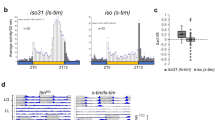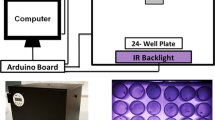Abstract
BRADY1 has discussed Truman's2 hypothesis that circadian clocks can be divided into two types: type 1 in which light seems to act directly on the oscillator, stopping it in constant light (LL); and type 2, in which the photoreceptor and oscillator are separate and the rhythm is free-running in LL. Typically, in insects, developmental events such as eclosion seem to be controlled by the first type, and daily behavioural activities by the second2. In Diptera, however, behavioural rhythms seem to be rapidly damped out by LL1; for example in the mosquito Anopheles gambiae, the ‘clock’ controlling flight activity seems to stop when the light phase is prolonged, and to restart at the next onset of darkness3, thus showing type 1 characteristics. Previously, the only known exception among the Diptera was Aedes aegypti, a light-active mosquito, in which the flight activity rhythm persists, rather weakly, in LL4. Here I show that circadian flight activity in the mosquito Culex pipiens fatigans Wied. persists in LL, although in other respects the rhythm is very similar to that in A. gambiae. As in A. gambiae3 the period of the first cycle in constant darkness (DD) is distorted by the previous light period, but, in contrast, the magnitude of the effect depends on a rhythm that evidently persists in LL.
This is a preview of subscription content, access via your institution
Access options
Subscribe to this journal
Receive 51 print issues and online access
$199.00 per year
only $3.90 per issue
Buy this article
- Purchase on Springer Link
- Instant access to full article PDF
Prices may be subject to local taxes which are calculated during checkout
Similar content being viewed by others
References
Brady, J., Adv. Insect Physiol., 10, 1–115 (1974).
Truman, J. W., Proc. int. Symp. circadian Rhythmicity Wageningen, 1971, 111–135 (Pudoc, Wageningen, Holland, 1971).
Jones, M. D. R., Nature, 245, 384–385 (1973).
Taylor, B., and Jones, M. D. R., J. exp. Biol., 51, 59–70 (1969).
Jones, M. D. R., Hill, M., and Hope, A. M., J. exp. Biol., 47, 503–511 (1967).
Jones, M. D. R., Cubbin, C. M., and Marsh, D., J. exp. Biol., 57, 337–346 (1972).
Jones, M. D. R., Cubbin, C. M., and Marsh, D., J. exp. Biol., 57, 347–357 (1972).
Pittendrigh, C. S., Z. PflPhysiol., 54, 275–307 (1966).
Jones, M. D. R., and Reiter, P., Nature, 254, 242–244 (1975).
Konopka, R. J., and Benzer, S., Proc. natn. Acad. Sci. U.S.A., 68, 2112–2116 (1971).
Author information
Authors and Affiliations
Rights and permissions
About this article
Cite this article
JONES, M. Persistence in continuous light of a circadian rhythm in the mosquito Culex pipiens fatigans Wied.. Nature 261, 491–492 (1976). https://doi.org/10.1038/261491a0
Received:
Accepted:
Issue Date:
DOI: https://doi.org/10.1038/261491a0
This article is cited by
-
A framework for practical and rigorous impact monitoring by field managers of marine protected areas
Environmental Monitoring and Assessment (2011)
-
Dynamic response of a circadian pacemaker
Biological Cybernetics (1981)
-
Dynamic response of a cricadian pacemaker
Biological Cybernetics (1981)
-
Rhythms in the biting behaviour of a mosquito Armigeres subalbatus
Oecologia (1980)
-
Do circadian oscillators ever stop in constant light?
Nature (1979)
Comments
By submitting a comment you agree to abide by our Terms and Community Guidelines. If you find something abusive or that does not comply with our terms or guidelines please flag it as inappropriate.



